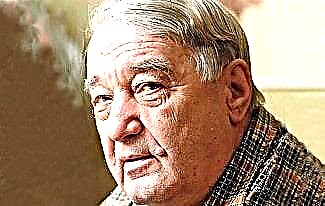George Washington (1732-1799) - American statesman and politician, 1st popularly elected President of the United States (1789-1797), one of the founding fathers of the United States, Commander-in-Chief of the Continental Army, participant in the War of Independence and founder of the American Presidency Institute.

There are many interesting facts in the biography of Washington, which we will talk about in this article.
So, here is a short biography of George Washington.
Biography of Washington
George Washington was born on February 22, 1732 in Virginia. He grew up in the family of a wealthy slave owner and planter Augustine and his wife Mary Ball, who was the daughter of an English priest and lieutenant colonel.
Childhood and youth
Washington Sr. had four children from a previous marriage to Jane Butler, who died in 1729. After that, he married a girl named Mary, who bore him six more children, the first of whom was the future president of America.
George's mother was a tough and uncompromising woman who had her own opinion and never succumbed to other people's influence. She always adhered to her principles, which later inherited her firstborn.
The first tragedy in the biography of Washington happened at the age of 11, when his father passed away. The head of the family left his entire fortune, consisting of 10,000 acres of land and 49 slaves, to the children. An interesting fact is that George got the estate (260 acres), more like a farm, and 10 slaves.
As a child, Washington was homeschooled with a strong focus on self-education. Having received the inheritance, he came to the conclusion that slavery was contrary to humane and ethical standards, but at the same time he recognized that the abolition of slavery would not come soon.
The formation of George's personality was greatly influenced by Lord Fairfax, who was one of the largest landowners of his time. He helped the young man manage the farm, and also assisted in building a career as a land surveyor and an officer.
After Washington's half-brother died at the age of 20, George inherited the Mount Vernon estate and 18 slaves. At that time, the biography, the guy began to master the profession of a land surveyor, which began to bring him his first money.
Later, George led one of the districts of the Virginia militia in the status of an adjutant. In 1753 he was assigned to carry out a difficult task - to warn the French about the undesirability of their presence in Ohio.
It took Washington about two and a half months to overcome the dangerous 800 km long route and, as a consequence, carry out the order. After that, he took part in the campaign to capture Fort Duquesne. As a result, the British vanguard, commanded by George, managed to occupy the fort.
This victory saw the end of French dominance in Ohio. At the same time, the local Indians agreed to go over to the side of the winner. It is important to note that peace agreements were signed with all the tribes.
George Washington continued to fight the French, becoming the commander of the Virginia Provincial Regiment. However, in 1758, the 26-year-old officer decided to retire.
Engaging in battles and fighting for his own ideals hardened George. He became a reserved and disciplined person, always trying to keep the situation under control. He was loyal to the religions of different people, but he himself did not consider himself an overly religious person.
Politics
After his retirement, Washington became a successful slave owner and planter. At the same time, he showed a great interest in politics. During the biography of 1758-1774. the man was repeatedly elected to the Legislative Assembly of Virginia.
As a major planter, George came to the conclusion that British policy was far from ideal. The desire of the British authorities to curb the development of industry and trade in the colonial territories was severely criticized.

For this and other reasons, Washington founded a society in Virginia to boycott all British products. Curiously, Thomas Jefferson and Patrick Henry were on his side.
The man did his best to defend the rights of the colonies. In 1769 he presented a draft resolution giving the right to establish taxes only for the legislative assemblies of the colonial settlements.
The tyranny of Britain over the colonies did not allow any compromise or reconciliation to be reached. This led to a confrontation between the colonists and the British soldiers. In this regard, Washington deliberately began to wear uniforms, realizing the inevitability of a break in relations.
War for independence
In 1775, George was entrusted with command of the Continental Army, which consisted of American militias. He managed in the shortest possible time to make the wards disciplined and prepared for the war soldiers.
In the beginning, Washington directed the siege of Boston. In 1776, the militia defended New York as best they could, but they had to surrender to the onslaught of the British.
A few months later, the commander and his soldiers took revenge in the battles of Trenton and Princeton. In the spring of 1777 the siege of Boston nevertheless ended in American success.
This victory increased the morale of the Continental Army, as well as self-confidence. This was followed by the victory at Saratoga, the de-occupation of the central states, the surrender of the British at Yorktown, and the end of the military conflict in America.

After high-profile battles, the rebels began to doubt that Congress would pay them a salary for participating in the war. As a result, they decided to make the head of state, George Washington, who enjoyed great authority with them.
The American Revolution formally ended in 1783 with the conclusion of the Paris Peace Treaty. Immediately after the agreement was signed, the commander-in-chief resigned and sent letters to the state leaders, where he recommended that they strengthen the central government to prevent the collapse of the state.
First President of the United States
At the end of the conflict, George Washington returned to his estate, while not forgetting to monitor the political situation in the country. He was soon elected head of the Philadelphia Constitutional Convention, which drafted the new US Constitution in 1787.
In subsequent elections, Washington won the support of voters, who unanimously cast their votes for him. After becoming president of the United States, he encouraged his compatriots to respect the Constitution and live in harmony with the laws prescribed in it.
At his headquarters, George recruited educated officials who sought to work for the good of the homeland. Cooperating with Congress, he did not intervene in internal political conflicts.
During his second term in office, Washington presented the program for the industrial and financial development of America. He saved the United States from being involved in European conflicts, and also banned the production of distilled spirits.

It is worth noting that the policy of George Washington was often criticized by certain masses, but any attempts to disobey were immediately suppressed by the current government. After the completion of 2 terms of office, he was offered to participate in the elections for the third time.
However, the politician refused such a proposal because it violated the Constitution. During the rule of the state, George officially renounced slavery in the country, but, as before, he managed his own plantation and looked for slaves who periodically escaped from it.
An interesting fact is that in total there were about 400 slaves under Washington's subordination.
Personal life
When George was about 27 years old, he married a wealthy widow, Martha Custis. The girl owned a mansion, 300 slaves and 17,000 acres of land.
The husband disposed of such a dowry very wisely, managing to turn it into one of the richest estates in Virginia.
In the Washington family, children never appeared. The couple raised Martha's children, who were born to her in a previous marriage.
Death
George Washington died on December 15, 1799 at the age of 67. A couple of days before his death, he was caught in a downpour of snow. Arriving home, the man immediately set to lunch, deciding not to change into dry clothes. The next morning, he began to cough violently, and then he could no longer speak.
The former president developed a fever that led to pneumonia and laryngitis. Doctors resorted to bloodletting and the use of mercury chloride, which only worsened the situation.
Realizing that he was dying, Washington ordered himself to be buried only 3 days after his death, as he was afraid of being buried alive. He kept a clear mind until his last breath. Later, the capital of the United States will be named after him, and his image will appear on the $ 1 bill.
Photo by George Washington
Below you can see interesting photos of images of George Washington. Here are the most interesting moments from the life of the first president of the United States, which were captured by various artists.






















